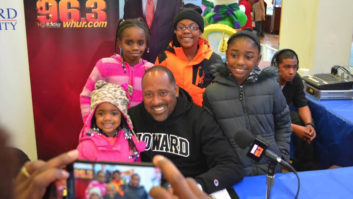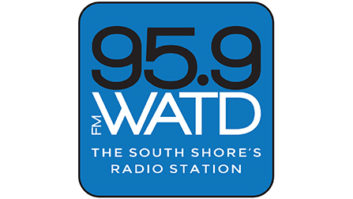If commercial broadcasters think about campus radio stations at all, they probably see them as a farm club for the major leagues.
For a different perspective, we spoke to some people who actually help run two such stations.
Each year the Michigan Association of Broadcasters Foundation names high school and college radio stations of the year. Radio World contacted the 2008 recipients.
What we heard is that students tend to see themselves as innovators, but ones who are not particularly interested in entering traditional radio jobs.
(click thumbnail)It’s Biffstock! Staff member Kevin Furlong and Program Director Ridwan Alam work a remote from Andover High’s main hallway during WBFH’s annual fundraising marathon. WDBM(FM) is the MABF’s College Radio Station of the Year. Gary Reid is the general manager of the station on the campus of Michigan State University in East Lansing.
“We are constantly trying to remain relevant, after 19 years,” he said. “We’ve gotten aggressive about video ever since we added cameras in the studio six or seven years ago. We originally just wanted to show the deejays, but that wasn’t too interesting. So with all the bands coming through the area, we determined that since we were recording audio, we should also record video. Now those performances are on our Web site.” That’s www.impact89fm.org.
But the evolution of the station is more fundamental than just adding music videos, according to Reid.
“It was obvious that college students were consuming radio in different ways than they used to,” he said. “This is a new generation of iPod users and instead of trying to buck the trend, our idea was to find out what people’s playlists were, and then add what an iPod can’t do: We put these people on the air to play and talk about their favorite music.”
The station receives between 20 and 30 submitted playlists from listeners each week via e-mail. Most of the songs are already in the station library; those that are not are brought to the station by the listeners. The station has two producers who help assemble the shows; it’s all packaged into a one-hour live broadcast each Friday night. These listener-hosted hours are also archived and made available as podcasts via the station Web site.
“We took the concept of personalized music and put it on the air, so we can let the passion that these listeners have invigorate our station,” said Reid.
WDBM is not connected to a specific academic degree program at the university, but Reid does teach audio and radio classes in addition to handling his job of overseeing the student station.
(click thumbnail)WDBM has captured best college station honors from the MABF eight out of the last nine years. Gary Reid is at far left, Mason Hunter of BMI is on the right. “The university wanted a professional manager they could fire, if you read between the lines,” he said. “I wrote the mission statement, which calls for ‘diversity in programming, professionalism in presentation and education.’ Everything we do is related to that.”
The station has about 100 volunteers, ranging from freshman to Ph.D. candidates; about 47 are on the air. WDBM operates 24/7/365 and the facility comprises about 4,000 square feet, with acoustics designed by Russ Berger Design Group. There are two on-air studios, a talk/performance room, a production control room and a news/sports production room. The station also has a music library.
But what is the goal of the station? Not to give birth to the next Casey Kasem or Rick Dees.
“Most of the people who join us here are interested in music,” said Reid. “Very few are interested in radio. One of our recent grads moved to New York and was embarrassed to tell me that she took a job in the coroner’s office as a DNA technician. She thought I would be disappointed because she had been one of our best jocks. But I wasn’t disappointed because she took the self-confidence and ability to work with others that she got here and moved into a satisfying job.”
But regardless of the lack of programming jobs out there, Reid still sees a future for radio.
“We believe in the viability of the medium,” he said. “We’re just trying to find new ways of making it important to our listeners’ lives.”
WDBM has captured “best college station” honors from the MABF eight out of the last nine years.
“We are only as good as our worst jock,” said Reid. “And you don’t want to be our worst jock.”
Social networks rule!
Andrew Blumberg, a student at Andover High School, has worked his way up from promotions director to operations manager at WBFH(FM) — The Biff 88.1 — which is the MABF High School Station of the Year.
While there is a broadcasting class associated with the station, it is not centered around preparing students to be DJs.
“Our course will be changing to include more media besides terrestrial radio,” he said of the class taught by professional station manager Pete Bowers. “We know that WBFH is a radio station and we’re interested in getting people to listen, but realistically there is a lack of radio jobs out there.”
But high school radio offers the chance to experiment with different ways of reaching an audience. To young people, radio is part of a world that includes social network sites on the Internet such as MySpace and FaceBook.
“Those have been a great way to let listeners know of events that are happening at WBFH,” he said.
“April 11, 2008 was the 32nd annual Biffstock 24-hour marathon in which we raise money for the station. In order to let people know about the concert that happened that night, a FaceBook group inviting staff members’ friends to the event was created. Other groups on the site have been started to publicize weekly shows and their hosts. The advent of social networking sites has been beneficial for stations as a majority of teens and young adults utilize them.”
Anyone who knows any teenagers knows that they spend approximately 100 percent of their free time on a cell phone.
“In the past week we added the opportunity for listeners to text-message us their requests and comments via cell phone,” said Blumberg. “Commercial stations might take note of how we cater to our listeners. It seems as though in recent years, (commercial) stations have been more focused on the advertising dollar as opposed to what the people who listen really want.”
Even though radio is only a small part of a teenager’s world, Blumberg believes the medium has a future.
“I think that programs in both college and high school give students hands-on experience that will allow them to explore many different positions in broadcasting that wouldn’t be available otherwise,” he said.
“On-air positions have been reduced recently but there is still a great need in engineering, sales and production. I’m not sure about my plans but I know that I’ll have a lot of knowledge from this experience that I’ll be able to take wherever I go.”
Listen live to “The Biff” at www.wbfh.fm.














